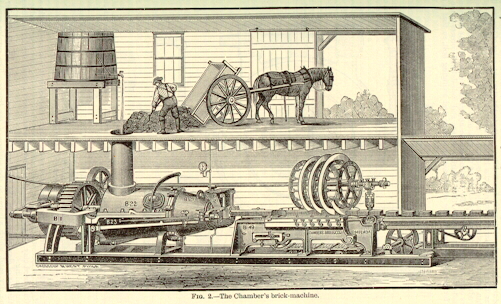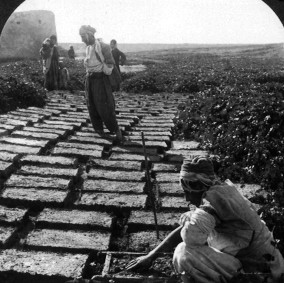Bricks
Today, let's talk about bricks. The University of Houston's College of Engineering presents this series about the machines that make our civilization run, and the people whose ingenuity created them.
The Third Little Pig built his house of brick, and the Big Bad Wolf didn't get very far trying to blow it down. Like the Second Little Pig, most of us build our houses of wood. It's cheaper. Today's market is filled with houses that've been made to look like they're brick but which are primarily wood.
Yet brick strikes us as a pedestrian material, and it really is a common denominator that goes back 10,000 years. The first bricks were sun-dried clays, often reinforced with grasses. The Book of Exodus tells how Pharaoh ordered straw withheld from the Hebrew people to keep them from making bricks. Perhaps, along the way, wooden houses with brick fireplaces burned down leaving the brick much stronger. After 2500 BC people caught on, and fired bricks began replacing adobe in India and the Middle East.
By the 2nd century AD, brick-making was so woven into the fabric of Roman life that Plutarch warned, "No man ever wetted clay and then left it, as if there would be bricks by chance and fortune." Bricks were used in England during centuries of Roman occupation. But when the Romans left, the art died out. The Saxons, who didn't know how to make brick, reused old Roman bricks.
After Rome, brick-making survived only in Italy. Central Europe rediscovered the art about the time of Charlemagne. England didn't relearn it until the 12th century. Then she made high art of brickwork. The old Roman bricks had been thin and broad, like large tiles. The English gave bricks their modern shape and set about to copy the complex forms once made of cut stone -- twisted chimneys, spiral staircases, stately mansions.
Here in America we used our huge supplies of virgin wood to imitate the columns and lintels of European stonework. But we still needed brick for ovens and chimneys. Even our first settlements, Roanoke and Jamestown, had crude brick kilns. English ships used bricks for ballast and hauled them across the ocean. The earliest bricks we've found in the Pacific Northwest were hauled halfway around the world to Vancouver Island in the 18th century.
How do we know an old brick was made in England, not America? I suppose one might use methods of forensic geology to find out, but this is easier. Brick clay is first cast in boxes and, for centuries, brick-makers have cast their marks into their bricks.
Shakespeare talked about brick in Henry VI. A commoner claims his father, a bricklayer, is the true king, switched at birth. In support, his friend cries, "He made a chimney in my father's house, and the bricks are alive at this day to testify to it." They give their claim credence by calling up the brick chimney which endures beyond the house itself. Brick still means solidity -- even today. What better can we say of a friend than, "He is a brick."
I'm John Lienhard, at the University of Houston, where we're interested in the way inventive minds work.
(Theme music)
Gurke, K., Bricks and Brickmaking: A Handbook for Historical Archaeology. Moscow, ID: The University of Idaho Press, 1987.
Brunskill, R., Clifton-Taylor, A., English Brickwork. London: Ward Lock Limited, 1977.
I am grateful to Margaret Culbertson, UH Art and Architecture Library, for suggesting the topic and providing the two source books; to Lynn Eichhorn, Virginia Polytechnic Institute, for considerable counsel on the use of brick in architecture; and to Dennis Houston, Rice University English Department, for advice on the sense of the Shakespeare quote.


A Nineteenth-Century Brickmaking Machine
Appleton's Cyclopedia of Applied Mechanics, 1892

And this is early 20th century brick-making in
Egypt -- a thousands of years old technology
Stereopticon image courtesy of Margaret Culbertson